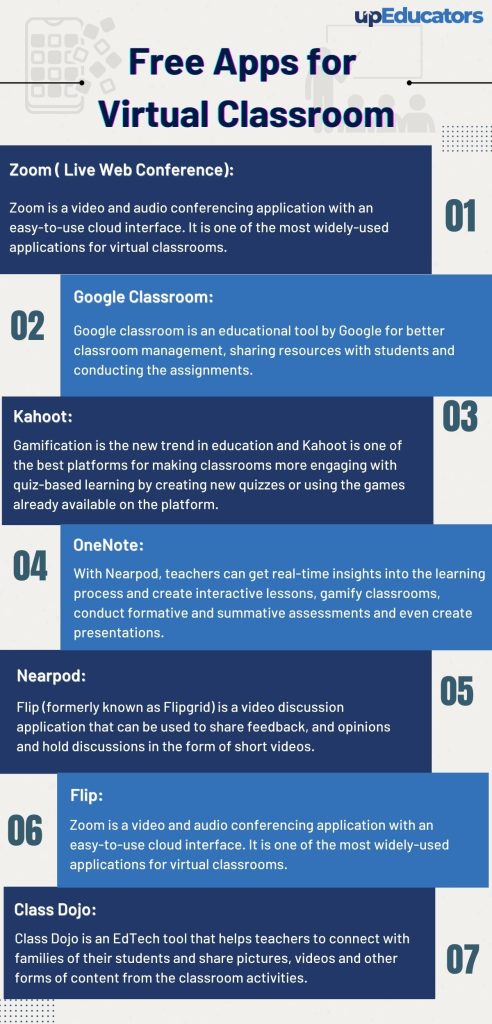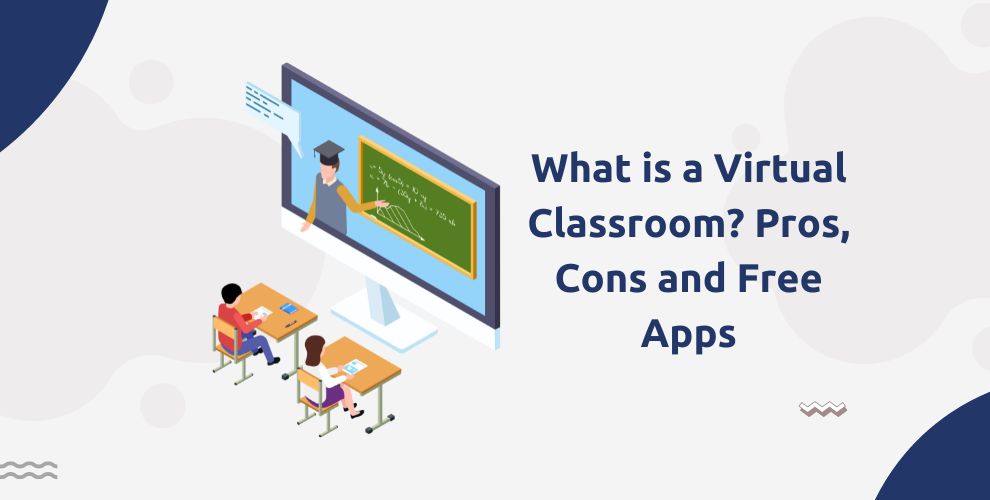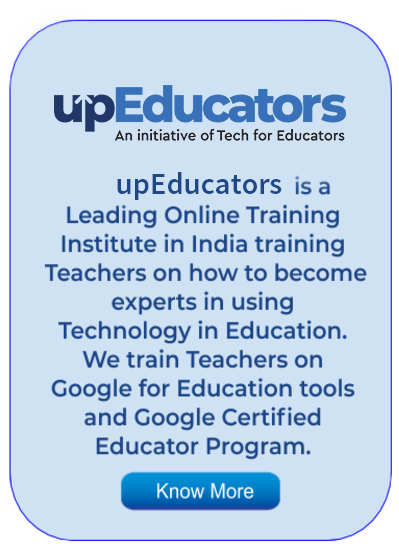Learning has evolved from physical classrooms to virtual classrooms. According to a recent survey by Guru99.com, more than 3 million students are taking online classrooms for higher education. The number of students learning online will grow in the coming years. The virtual classroom is a trending buzzword in the education sector. But what is a virtual classroom and how can teachers use virtual classrooms to teach in the present scenario?
upEducators has trained 5000+ teachers in developing digital skills and pedagogies. The positive trends in learning digital skills through programs like Microsoft Certified Educators and Google Certified Educators show the increase in virtual learning practices. Thus, modern-day educators need to become experts in virtual classrooms.

In this article, we will discuss:
Virtual classrooms
Types of virtual classrooms
Benefits and Importance of Virtual Classrooms
Demerits of Virtual Classrooms
Tools Required for Virtual classrooms
Free Applications for Virtual Classrooms
What is a Virtual Classroom?
A virtual classroom is an online learning environment that allows students and teachers to interact with each other via the internet. Virtual classrooms typically use learning management systems to give students access to course materials, assignments, and tests. Many virtual classrooms also provide features such as video conferencing and chat rooms to facilitate communication between students and teachers.
Types of Virtual Classrooms
There are a few different types of virtual classrooms that are popular among educators and students.
Synchronous Virtual Classroom: The most common type is the synchronous virtual classroom, which is a live, online classroom where all participants are logged in at the same time. This type of classroom allows for real-time interaction between the teacher and students, and between students themselves. For example, platforms such as UpEducators offer synchronous learning environments.
Asynchronous Virtual Classrooms: Another popular type of virtual classroom is the asynchronous virtual classroom, which is an online classroom where participants are not logged in at the same time. This type of classroom is often used for self-paced courses or for students who are unable to meet at a certain time. For example, platforms likeUdemy and Coursera offer asynchronous learning environments.
Blended Virtual Classroom: Finally, there is the blended virtual classroom, a combination of synchronous and asynchronous virtual classrooms. This type of classroom is often used for courses that have both live and self-paced components.
Benefits and Importance of virtual classrooms
Virtual classrooms offer many advantages over traditional, face-to-face classrooms.
- Flexibility: Virtual classrooms provide greater flexibility for both students and teachers. Students can log in to the virtual classroom from anywhere with an Internet connection and access the class materials at any time.
- Better Collaboration: Virtual classrooms also offer a more collaborative learning environment, as students can easily communicate and work together on projects.
- Immediate Feedback: Delayed feedback tends to hamper the overall progress in the classroom. With virtual feedback tools, teachers can make the teaching-learning process swifter.
- Improves Digital skills: Gadgets and technology are being used in every domain of life. Virtual classroom helps improve the digital skills of not only students but teachers too. For instance, teachers can enrol on programs like Google Certified Educators or Microsoft Certified Educators and gain digital skills to apply in the classroom.
- Time Management: With virtual classrooms, both teachers and students get to save a lot of hours. There is no need to commute to reach a physical destination. Thus, a lot of time is saved that can be sued in improving and building a learning environment.
Demerits of Virtual Classroom
Virtual classrooms have many disadvantages that can impede student learning.
- First, the quality of the virtual classroom experience can be quite poor, with spotty audio and video connections and lag times that can make it difficult to follow along.
- Additionally, students can be easily distracted in a virtual classroom, with email, social media, and other online distractions only a click away.
- Finally, virtual classrooms can feel quite impersonal. This can make it harder for students to engage with the material and with each other.
What is required for virtual classrooms?
Virtual classrooms take place in a virtual space using technology and devices. All the parties participating in a virtual classroom need certain tools, (software and hardware) to make a virtual classroom work. These are some of the tools that are required for virtual classrooms.
- The first is a computer with an internet connection.
- The second is a microphone and speakers so that you can be heard by your students.
- The third is a webcam so that your students can see you.
- The fourth is a whiteboard so that you can write and draw on it.
- The fifth is a pen and paper so that you can take notes.
The last thing you need is a good attitude and a willingness to learn! Thus, along with these physical tools and technologies, virtual classroom users need to follow the best practices. Read this article to know the best virtual classroom etiquette for teachers.
Free Applications for Virtual Classrooms
The internet and devices like laptops and desktops are the prerequisites for setting up virtual classrooms. But different applications are responsible for making the virtual classrooms work.
upEducators has worked with thousands of teachers and trained them in digital skills and pedagogies. After research and experience, our team has curated a list of the best applications that can be used for virtual classrooms. Here are some of the best applications for virtual classrooms:
- Zoom (Live Web Conference): Zoom is a video and audio conferencing application with an easy-to-use cloud interface. It is one of the most widely-used applications for virtual classrooms.
- Google Classroom: Google classroom is an educational tool by Google for better classroom management, sharing resources with students and conducting the assignments
- Kahoot: Gamification is the new trend in education and Kahoot is one of the best platforms for making classrooms more engaging with quiz-based learning by creating new quizzes or using the games already available on the platform.
- OneNote: A single-stop digital solution for not-making, OneNote allows users to gather different forms of notes. Users can create a single virtual space for note-making, be it audio, visual or written notes. Users can even collaborate with other members for note-making.
- Nearpod: With Nearpod, teachers can get real-time insights into the learning process and create interactive lessons, gamify classrooms, conduct formative and summative assessments and even create presentations.
- Flip: Flip (formerly known as Flipgrid) is a video discussion application that can be used to share feedback, and opinions and hold discussions in the form of short videos.
- Class Dojo: Class Dojo is an EdTech tool that helps teachers to connect with families of their students and share pictures, videos and other forms of content from the classroom activities.
- Quizlet: Quizlet allows better learning with the use of flashcard quizzes. Users can even create their flashcards or use the ones available on the application.
- Padlet: Padlet can be used by students and teachers to create visually-appealing projects and even collaborate on these projects.
Read a detailed discussion on these apps here. (Link to apps in the classroom blog)
Teaching and learning in the 21st century are still evolving. But with virtual classrooms, students and educators are now able to learn from miles away. Virtual classrooms have made learning remotely easier and more convenient. With the help of many applications and tools for virtual learning, more people can learn without physical barriers.
Author: This article is written by Samiya Rashid for upEducators blog.




